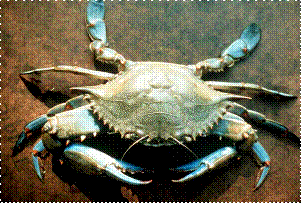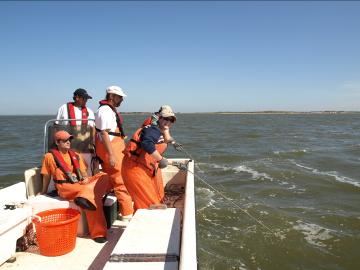Ecological Determinants of Hematodinium Epidemics in the American Blue Crab: The Effect of Fishing Pressure on a Pathogenic Disease |
 |
EID PROJECT OVERVIEW
In 1997, blue crabs supported the largest commercial fishery in the Chesapeake Bay, and the second largest fishery in Virginia (Kirkeley 1997). The crab industry typically harvests from 80-120 million pounds from Chesapeake Bay annually, of that, approximately 10-14 million pounds were soft-shell crabs (Johnson et al. 1998). However, major declines in crab catches have occurred since 1998 with the downward trend only stabilizing in 2004 (Chesapeake Bay Commission 2003,2004). While fishing pressure continues to be cited for the recent declines, disease and environmental processes have not been well examined; yet both processes have contributed to declines and population cycles in other crustacean fisheries (see Kuris & Lafferty 1992, for review.)
The blue crab - Hematodinium system is intended to be a general model to gage the near universal effect of fishing on population size and age structure (i.e., the “juvenization” of the population) and thus on the spread of pathogenic diseases most prevalent among juveniles (Fig. 5). This area has received little attention, which is surprising given the increasing reports of diseases in marine populations, many of which experience significant fishing pressure. This system makes a tractable model because blue crabs are relatively easy to capture and maintain, the disease can be rapidly diagnosed and maintained via serial infections, and fishing pressure can be reasonably documented and modeled. Therefore, we will build a predictive model to coordinate the following objectives:
(I) To assess the prevalence and spatial distribution of Hematodinium infections in juvenile and adult blue crabs in relation to the physiography and hydrography of coastal bays on the Delmarva Peninsula.
(II) To determine the effect of the blue crab fishery on the population structure of healthy and diseased blue crabs.
(III) To determine how environmental factors affect infections in blue crabs and how they affect the life history and spread of the pathogen.
(IV) To clarify the modes of transmission, their efficiencies in relation to host factors and alternate transmission pathways in the life history of the parasite.
(V) To build a model to identify underlying mechanisms that control the spread of disease and predict outbreaks in relation to changes in fishing pressure and environmental stressors.
While we focus on a protozoan disease in the blue crab as a model system, our model has broad application to other fisheries.
METHODS
|
Spatial sampling of crags: Monthly collections will be made at approximately 20 sites within selected coastal bays and creeks on the Delmarva Peninsula (Fig. 4). Crabs will be returned to the lab measured, sexed, assessed for molt stage and examined for Hematodinium using established methods (Messick & Shields 2000, Shields et al. 2005). Seasonal and spatial distribution of dinospores: We have developed a sensitive and specific polymerase chain reaction (PCR) primer set for identifying the presence of Hematodinium in hemolymph. For 3 years, water samples (500 ml ea) will be collected and processed from each sample location monthly to determine the presence of Hematodinium via PCR. Fishing and crab population structure: The structure of the blue crab population will be assessed by examining size-frequency distributions from fished crabs and crabs captured in our monthly surveys. For fished crabs, random surveys will be undertaken monthly of the fishermens' catches in which we will measure the carapace width, carapus width, sex and maturity status of captured crabs. Crab abundance, density and inter-estuary movement: We plan a series of short-term tag-to extimate crab abundance and to obtain recapture studies estimates of movements between estuaries. Salinity, temperature, dissolved oxygen: Laboratory challenge experiments will be undertaken with blue crabs inoculated with the parasite and held under different temperature, salinity, or dissolved oxygen regimes. Estivation/Latency: Studies on the estivation of infections will focus on PCR and histological assessment of overwintering crabs and the holding of naturally infected and experimentally inoculated crabs under different temperature conditions over winter. Immune suppression: Phagocytosis assays will be undertaken in sets of animals from the above experiments. Transmission studies: In separate, controlled experiments we will examine potential routes of transmission (sporulation, cannibalism, the role of molting, injury and alternate hosts) to estimate transmission rates Alternate Hosts: Other crustaceans (e.g., amphipods, isopods, several other crabs species – Messick & Shields 2000) will be caught in the surveys and analyzed. Sentinels: Sentinel studies have long been employed to monitor for viral infections in reservoir populations of birds and other animals (e.g., Reisen et al. 1995). Using sentinel studies we can determine the incidence of new infections and gain information on the timing of transmission. Model Development: Using the Hematodinium-crab interaction as a model system, we will investigate, through computer simulations, a series of fundamental issues concerning disease dynamics in anthropogenically-impacted marine ecosystems. |
|



